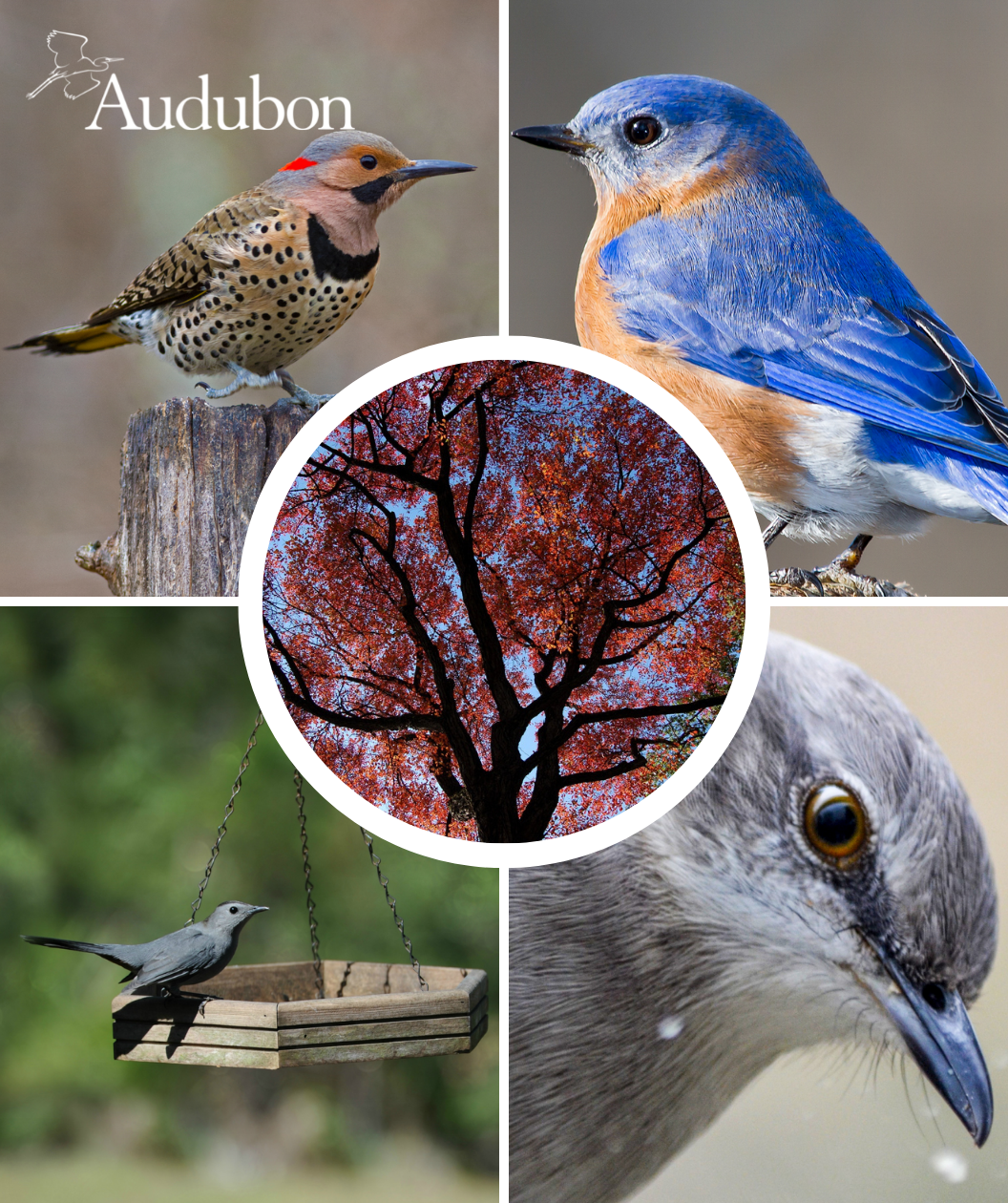







MAGNIFICENT FLOWERING NATIVE TREE WITH BRIGHT FALL COLOR
FEATURES:
May Benefit & Attract: wild turkeys, robins, woodpeckers, mockingbirds, brown thrashers, thrushes, and flickers
- Tiny clusters of green yellow flowers bloom in spring, maturing to dark blue berries in late summer
- Stunning crimson, yellow-orange and purple fall color
- Shining green leaves on pyramidal canopy
- Fast-growing and disease resistant
- Wonderful when used as a specimen shade tree or when planted in a grove
- This bird-friendly native plant provides food and shelter for local and migrating birds and other wildlife
- All Audubon® branded trees and plants are grown 100% Neonic-free by Bower & Branch, making these plants safer for the birds and safer for the environment
- The National Audubon Society protects birds and the places they need, today and tomorrow
- Hand Selected, Fresh from our Grower
- Ships on our trucks because of the size of the tree - does not fit in a box
Growth Facts
- Hardiness Zone: 4-9
- Mature Height: 40-60' tall
- Mature Width: 20-30' wide
- Exposure: Full Sun/Part Shade
- Spacing: 20-30' apart
MAGNIFICENT FLOWERING NATIVE TREE WITH BRIGHT FALL COLOR
FEATURES:
May Benefit & Attract: wild turkeys, robins, woodpeckers, mockingbirds, brown thrashers, thrushes, and flickers
- Tiny clusters of green yellow flowers bloom in spring, maturing to dark blue berries in late summer
- Stunning crimson, yellow-orange and purple fall color
- Shining green leaves on pyramidal canopy
- Fast-growing and disease resistant
- Wonderful when used as a specimen shade tree or when planted in a grove
- This bird-friendly native plant provides food and shelter for local and migrating birds and other wildlife
- All Audubon® branded trees and plants are grown 100% Neonic-free by Bower & Branch, making these plants safer for the birds and safer for the environment
- The National Audubon Society protects birds and the places they need, today and tomorrow
- Hand Selected, Fresh from our Grower
- Ships on our trucks because of the size of the tree - does not fit in a box
Growth Facts
- Hardiness Zone: 4-9
- Mature Height: 40-60' tall
- Mature Width: 20-30' wide
- Exposure: Full Sun/Part Shade
- Spacing: 20-30' apart
Why plant Audubon® Native Black Gum?
Well known as one of the most beautiful native trees, Black Gum Trees are etched with seasons of magnificent features! A bevy of hummingbirds and butterflies flock to this beauty in spring as clusters of delicate white flowers bloom for many months. A true sight to see as you relax on your patio, watching a host of colorful winged friends flutter throughout your yard. Shining dark green leaves shimmer in the wind like an elegant chandelier. In fall, you’ll want to hoist up a hammock under the large canopy of red, orange, and yellow autumn leaves. Native honey bees and birds particularly love the small fruits that ripen in fall. A widely beneficial shade tree not on you but also for the health of your local ecosystem!
The early settlers on Martha's Vineyard learned from the native Wampanoag how to manufacture whale oil. As demand for oil grew they began storing and shipping the oil in wooden casks. The Black gum tree, native to the island was key in this production. The gnarled grain of the Black gum resists splintering and was used for making the beetle, or mallet and the bungs, which are the wooden stoppers in the casks. This tree is known to the Islanders as the Beetlebung Tree.
How to use Audubon® Native Black Gum in the landscape?
It isn’t the prettiest name, but wait until you see the gorgeous fiery fall color. This environmentally friendly native tree is moderately sized and has some of the most glorious fall color you will ever see! Use it to line your driveway or fence line for a stunning show each fall! Or, if you're a beekeeper, plant this native Tupelo in order to harvest tupelo honey!
Audubon® Native Plants & Trees
Audubon is devoted to protecting birds and the places they need, while Bower & Branch is devoted to the growth of true native trees and plants–no cultivars or hybrids. Together, we strive to unite communities in conservation and inspire individuals to cultivate a better world for birds starting in their own backyards, balconies, or patios. By guiding and recommending trees and plants truly native and beneficial to your region, we can really start to make a difference.
What is the definition of Native?
“In the United States, a native plant is defined as one that was naturally found in a particular area before European colonization. Native plants are the foundation of a region’s biodiversity, providing essential food sources and shelter for birds, especially those threatened by the changing climate. Since native plants are adapted to local precipitation and soil conditions, they generally require less upkeep, therefore helping the environment and saving you time, water, and money.” – The National Audubon Society
Learn how you can help birds in your home and community through Audubon’s Plants for Birds program.
Audubon® is a licensed and registered trademark of the National Audubon Society. All rights reserved.
Planting Zones
Hardiness Zone: 4-9
How To Plant Audubon® Native Black Gum
You cannot plant a finer shade tree than the Black Gum! They prefer full sun, but also tolerates light shade. Black Gums can grow in a wide range of soil conditions and they are free of any major pest or disease problems. This long-living tree is one of the first trees to show fall color and it’s some of the best fall color I’ve ever seen! The Black Gum, when young, will start out by growing rather slowly and have a slightly irregular growth habit, but once established it will take off and become an awesome attention grabber!
How To Water
Once you plant your tree, remember to keep it well watered during the first year in the ground. Water twice weekly for the first 3-5 weeks; then water weekly for the remainder of the year until winter. When you water, water slowly and thoroughly. Watering needs may be altered due to extreme weather conditions.
How To Fertilize
When planting, mix Bower & Branch Elements Starter Plant food granular form into the soil. After that, fertilize each year in early spring before your tree breaks dormancy.
How To Prune
The best time to prune your Black Gum tree is in late winter. Simply remove any damaged or dead branches that you see for the overall health of your tree.
Videos
How Does Shipping Work?
Bower & Branch Trees, the real BIG trees, don’t fit in a box! Our big trees, sizes XL and bigger, require expert delivery and care, that means our extra-large trees are shipped on Bower & Branch trucks. We are the only ones who know how to ship our big and bigger trees and plants with tender loving care. We deliver your trees and plants directly to you. Ask Bower & Branch about planting services – we'd be happy to assist in installation.
*For Big trees and Shrubs, Size XL and bigger: Review our Seasonal Shipping Timelines and Policy here.
Your trees and plants are grown across the United States at various Bower & Branch Growers. Depending on your location, your plant orders may be shipped from various locations. Please expect orders with multiple items to be delivered over a number of days as a result. Orders made up of numerous items or selections will not arrive at your home on the same day.
Shipping Delays:
From time to time, Bower & Branch Growers may determine to delay order shipment based on various factors for plant health. Weather in your region, as well as, where your plants are grown, is always considered when shipping. Extreme weather conditions may delay some or all of your order. Bower & Branch allows our Growers to make final shipping decisions based solely to benefit your trees and plants’ health and success.
How Does Sizing Work?
The size of our trees have nothing to do with the container size like you may find elsewhere–big doesn't mean just height - it’s also vigor, age, and overall health. Other online retailers are going to tell you that a plant is a seven gallon, that means nothing to your tree or plant (or you.)
Our trees for sale online are graded on large, x-large, and even bigger sizes. This is because our trees are sized by their age—the higher the letter, the more mature the tree. The age determines the trees’ overall height, size of the trunk and the overall branch density.
All of these characteristics are what you should be looking for when choosing a tree for immediate impact and instant curb appeal. Our extra-large tree and plant sizes are sure to wow you and your neighbors!
See the size guides below.






Our Guarantees
3-YEAR-TREE GUARANTEE:
Bower & Branch offers a Three-Year Tree Guarantee on all of our trees, sizes X-Large and up. Only the finest and the most experienced growers are awarded the opportunity to grow for Bower & Branch, so we offer the best guarantee available.
If your tree(s) should fail for any reason during the three-year guarantee period, you will receive an online gift card in the amount that you originally spent on the tree.* You can then use this online gift card for any Bower & Branch Purchase.
* Bower & Branch provides online gift cards in the amount of the original purchase price of the tree(s). The amount does not include any additional costs such as delivery, planting, tax, or any other products or services. Online gift cards can be applied towards any Bower & Branch purchase on BowerandBranch.com and have no expiration dates. Bower & Branch does not guarantee tree replacement or availability of any desired product at any time. Cash refunds are not offered. Bower & Branch requires that all original tags and receipts are present when a guarantee request is initiated. The Bower & Branch Three-Year Guarantee only applies to plant material that has been planted in the ground. Container plantings are NOT covered.
At Bower & Branch, we do our best to honor all guarantee fulfillment requests to ensure customer satisfaction. However, we reserve the right to refuse the request if the required guarantee steps were not satisfied. Bower & Branch also reserves the right to deny any guarantee fulfillment request that is made as a result of animal damage, problems with plant hardiness and zone issues, or acts of nature (snow storms, hurricanes, and similar).
Reach out to a Plant Whisperer with any questions:
- Email: plantwhisperers@bowerandbranch.com
- Phone: 866-873-3888
- Or via Online Chat





